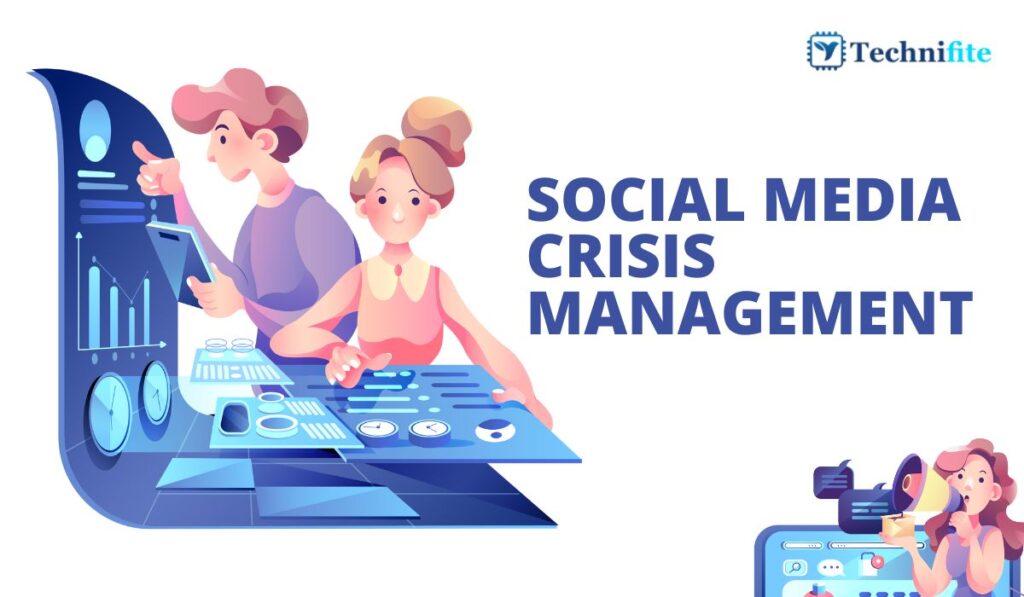Social Media Crisis Management: In the age of digital connectivity, social media has become an integral part of our lives, both personally and professionally. Social media platforms offer businesses and brands unparalleled opportunities to connect with their audience, promote their products or services, and build a strong online presence. However, with great power comes great responsibility, and the rapid spread of information on social media means that negative publicity can escalate quickly, posing a significant threat to a brand’s reputation. In this blog, we will explore the world of social media crisis management, examining strategies and best practices for handling negative publicity and restoring brand reputation.
Understanding Social Media Crisis
Before delving into the strategies for crisis management, it’s crucial to understand what constitutes a social media crisis. A social media crisis can be defined as any situation where negative information, comments, or events related to a brand or organization gain significant traction on social media platforms, potentially causing harm to the brand’s reputation, customer trust, and overall business operations.
Common triggers for social media crises include:
- Product or Service Failures: If a product or service doesn’t meet customer expectations, and customers take to social media to express dissatisfaction, it can escalate into a crisis.
- Controversial Statements or Actions: In today’s socially conscious world, any controversial statement or action by a brand or its representatives can quickly lead to backlash on social media.
- Data Breaches or Security Issues: When customer data is compromised due to security breaches, it can damage a brand’s trustworthiness and reputation.
- Employee Misconduct: Employee misconduct, especially when caught on camera, can go viral and tarnish a brand’s image.
- Negative Publicity Campaigns: Competitors, dissatisfied customers, or activist groups may launch negative campaigns targeting a brand.
The Importance of Social Media Crisis Management
Ignoring a social media crisis or responding inadequately can have serious consequences for a brand. These consequences may include:
- Reputation Damage: Negative comments and posts can harm a brand’s image, making it less attractive to potential customers and eroding the trust of existing ones.
- Loss of Customers: A mishandled crisis can lead to customer churn, as people may choose to do business with competitors perceived as more reliable or ethical.
- Financial Impact: A damaged reputation can lead to decreased sales and revenue and increased marketing and PR expenses to repair the damage.
- Legal and Regulatory Issues: Some social media crises may lead to legal challenges or regulatory scrutiny, harming the brand’s financial standing.
Given these potential consequences, proactive social media crisis management is essential for safeguarding a brand’s reputation and minimizing damage.
Key Strategies for Social Media Crisis Management
To effectively handle negative publicity on social media and restore brand reputation, businesses should follow a set of key strategies and best practices:
1. Monitor Social Media Constantly
The first step in crisis management is early detection. Brands should use social media monitoring tools to inform them about mentions, comments, and discussions about their products or services. Real-time monitoring allows for a swift response when negative publicity arises.
2. Have a Crisis Management Team in Place
A well-prepared crisis management team is essential. This team should include representatives from various departments, such as PR, marketing, legal, and customer support. Assign specific roles and responsibilities to team members to ensure a coordinated response.
3. Assess the Situation Thoroughly
Before responding, it’s crucial to understand the scope and severity of the crisis. Is it a minor issue that can be resolved with a simple apology, or is it a major incident that requires a comprehensive crisis communication plan? Thorough assessment is key to making informed decisions.
4. Respond Quickly and Transparently
In the world of social media, silence can be damaging. Respond promptly to negative comments and posts, acknowledging the issue and expressing concern. Transparency is vital; if mistakes were made, admit them and outline the steps to rectify them.
5. Apologize Sincerely
A sincere apology can go a long way in defusing a crisis. Avoid generic, scripted apologies and acknowledge the affected parties’ specific concerns. Show empathy and a genuine commitment to addressing the issue.
6. Engage with Stakeholders
Engage with customers and stakeholders through social media channels. Respond to questions and concerns openly and honestly. Active engagement demonstrates a commitment to resolving the issue and rebuilding trust.
7. Consider Offline Communication
In some cases, it may be more appropriate to address the crisis offline. Provide contact information for a dedicated customer support team or email address where affected parties can communicate privately. This can prevent further escalation of the issue on social media.
8. Develop a Crisis Communication Plan
A crisis communication plan is a pre-established set of guidelines and procedures for handling crises. It should include templates for responses, contact information for key team members, and a clear escalation process. Regularly review and update this plan to ensure its effectiveness.
9. Educate Employees on Social Media Policies
Employees can be both assets and liabilities in a crisis. Ensure that your employees are aware of social media policies, especially if they represent the brand online. Train them on how to handle negative comments or crises appropriately.
10. Monitor and Adjust Your Strategy
After the crisis has been addressed, continue to monitor social media for any lingering issues or new developments. Analyze the effectiveness of your crisis management strategy and make adjustments as needed to prevent similar incidents in the future.
11. Learn from the Experience
Every crisis provides an opportunity to learn and improve. Conduct a post-crisis review to identify what went well and what could be done better. Use these insights to enhance your crisis management strategy.
Conclusion
In today’s hyper-connected world, social media crises are unfortunate for businesses and brands. However, with the right strategies and a proactive approach, these crises can be managed effectively, and brand reputation can be restored.
By monitoring social media, having a well-prepared crisis management team, responding transparently and empathetically, and learning from past experiences, businesses can navigate the challenges of social media crises and emerge stronger on the other side. Remember, a crisis is not just a challenge but an opportunity to showcase your brand’s integrity, resilience, and commitment to customer satisfaction. Through thoughtful and strategic crisis management, businesses can turn negative publicity into a chance to reinforce their values and rebuild trust with their audience.
Frequently Asked Questions (FAQs)
What is social media crisis management, and why is it important for businesses?
Social media crisis management refers to the strategies and techniques businesses use to handle negative publicity and manage crises that occur on social media platforms. It involves monitoring social media channels, assessing the situation, responding promptly and transparently, and engaging with stakeholders to mitigate the impact of a crisis on a brand’s reputation. It is crucial for businesses because social media crises can spread rapidly, damaging reputation, customer trust, and financial stability. Effective crisis management can help minimize the damage and restore the brand’s image.
What tools or methods can I use to monitor social media for negative publicity?
Various social media monitoring tools, such as Hootsuite, Mention, and Brandwatch, allow you to track brand mentions, keywords, and hashtags across different social media platforms. Google Alerts is another useful tool to monitor web mentions. Additionally, setting up alerts for specific keywords and hashtags on social media platforms can help you stay updated in real time. Regularly monitoring these sources lets you detect negative publicity early and respond swiftly.
What elements should be included in a crisis communication plan for social media crises?
A comprehensive crisis communication plan should include:
Contact Information: Details of key team members and external contacts.
Response Templates: Pre-prepared responses for various types of crises.
Escalation Procedures: Clear guidelines on when and how to escalate the issue internally.
Roles and Responsibilities: Defined roles for team members during a crisis.
Social Media Guidelines: Protocols for engaging on social media during a crisis.
Monitoring Protocols: Procedures for continuous monitoring of social media channels.
Post-Crisis Evaluation: A process for reviewing the crisis management response to identify areas for improvement.
A well-structured plan ensures a coordinated and effective response to social media crises.
After resolving a social media crisis, how can a brand rebuild trust with its audience?
Rebuilding trust after a social media crisis requires consistent effort and genuine commitment. Key steps include:
Apologize Sincerely: Offer a sincere apology, taking responsibility for the issue.
Transparency: Be open and transparent about the actions to address the problem and prevent a recurrence.
Engage with Stakeholders: Actively engage with customers, respond to their concerns, and demonstrate a willingness to listen and learn.
Deliver on Promises: Follow through on commitments made during the crisis, showing that the brand’s words are backed by action.
Learn and Improve: Analyze the crisis management process, identify weaknesses, and implement improvements to prevent similar incidents in the future.
Trust can be gradually rebuilt by demonstrating authenticity, accountability, and a focus on customer satisfaction.
How can employees contribute to effective social media crisis management?
Employees play a crucial role in social media crisis management:
Training: Provide training on social media policies and guidelines to ensure employees can represent the brand online.
Vigilance: Encourage employees to report any concerning social media activity promptly, allowing for a swift response.
Teamwork: Foster a sense of teamwork and communication among employees to ensure a coordinated effort during a crisis.
Responsiveness: Empower employees to promptly respond to customer inquiries and concerns, reflecting the brand’s commitment to addressing issues.
Feedback: Encourage employees to provide feedback on the crisis management process, enabling continuous improvement.


